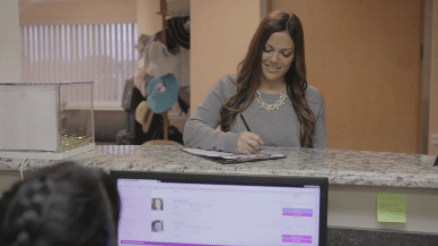Five Tips for Attracting Millennial Patients

Part of the solution includes modern dermatology software and technology.
Even though dermatologists care for patients of every age, there are reasons for dermatology practices to pay special attention to millennial patients. Born between 1981 and 1996, millennials are currently aged between 24 years old – around the age experts recommend making regular dermatology visits – and 39 years old, when signs of aging are a common concern.
The millennial generation makes up nearly a quarter of the U.S. population – the largest generation in U.S. history – and, according to Statista, are estimated to have an annual expenditure of $1.4 trillion in 2020. Another defining feature reflects their status as the first generation of “digital natives,” and the importance of the Internet and technology in their lives.
So how can dermatology practices better position themselves to tap into this huge, lucrative, tech-savvy market? Here are five important factors to consider for attracting millennial patients to your practice.
1. Consider Their Needs and Wants
 One way to attract millennial patients is to cater to their specific concerns, as well as their unique approach to wellness and self-care.
One way to attract millennial patients is to cater to their specific concerns, as well as their unique approach to wellness and self-care.
Millennials generally take interest in preventative skin care earlier than young people in previous generations. It is also important to note that millenial men can be increasingly more attentive to their skin care needs, and more likely to pursue treatment for dermatological issues.
As the older members of the millennial generation reach their 30’s and 40’s, it’s reasonable to expect increased demand for non-invasive cosmetic treatments and procedures, like fillers and other injectables. In fact, even younger millennials may be interested in cosmetic dermatology procedures that provide subtle, temporary changes, rather than invasive, risky and permanent surgeries.
Overall, millennials are generally more health-conscious, and dedicated to “self-care.” Dermatologists may be able to capitalize on this mindset by promoting their practice and services as therapeutic – if not a little indulgent – as well as clinical.
2. Create an Engaging Online Presence
 Before a patient steps foot in your office, they have to find it first. Millennials are likely to turn to the Internet to find their ideal dermatology practice. Without a strong online presence, millennials may not know your practice even exists.
Before a patient steps foot in your office, they have to find it first. Millennials are likely to turn to the Internet to find their ideal dermatology practice. Without a strong online presence, millennials may not know your practice even exists.
Here’s how to remedy that problem:
- Create your Google Business Profile with your physical address, phone number, web address and office hours. Be sure to include photos of your office building, as well as the interior.
- Create your practice website with office information and resources enhanced for search engine optimization (SEO). If you have a patient portal – more on that later – be sure to link to it also.
- Social media profiles are a great way to reach and engage with patients. Encouraging patients to share their dermatology success stories and tag your practice may work to increase trust, and potentially attract more millennials to your office.
3. Be Transparent About Insurance and Cost
Just like the Internet makes it easy for consumers to compare prices before making purchases, it also allows patients to easily research the average cost of medical procedures. Millennials, who can be especially savvy at price comparison, use this information to shop around for physicians that can offer the best balance of quality and cost.
Gain and keep the trust of millennial patients by making sure accepted insurances and cost estimates for common treatments are readily accessible for staff answering questions in the office or over the phone.
4. Offer Convenience
For millennials, convenience is often a major factor in their decision-making. New dermatology practices looking to cater to this generation can choose an office location close to where millennials live and work, with few competing practices, and ideally in a space that millennials will find accessible and aesthetically pleasing.
But there are other things that new and already-established dermatology practices alike can offer to better appeal to millennial patients:
- Provide extended or weekend hours: Many adults find it hard to make time for doctor appointments, especially when their work schedules are the same as most practice’s office hours. Appointment slots early in the morning, in the evening or on weekends can make your dermatology practice more convenient – and attractive – to busy millennials.
- Sell products in-house: Turn your practice into a one-stop-shop for skin care needs by offering patients the ability to buy recommended products at your office. It can be easier for patients to follow advice for skin care and sun protection regimens when they can conveniently purchase products after their appointment without needing to pick them up elsewhere.
- Add a few amenities: Small luxuries like self-serve coffee bars and free wifi are small conveniences that can make a big impact. A well-designed waiting room with comfortable, trendy furniture can help patients feel more welcome at your practice – and it looks good on social media, too. Want to be the coolest dermatology practice on Instagram? Switch out a few regular waiting room chairs for massage chairs.
5. Leverage Technology
 As technology rapidly grows and evolves, millennials keep pace, embracing the convenience of all things digital. They have come to expect to get more of what they want, when they want it, and with the best quality possible. It is safe to assume that millennial patients will have the same expectations when they enter your dermatology practice.
As technology rapidly grows and evolves, millennials keep pace, embracing the convenience of all things digital. They have come to expect to get more of what they want, when they want it, and with the best quality possible. It is safe to assume that millennial patients will have the same expectations when they enter your dermatology practice.
Here are some ways to use dermatology software and practice management technology to streamline your practice and keep millennials satisfied:
- iPad Patient Kiosk: Save time – and trees – by letting patients check in on an iPad, instead of the traditional, unwieldy paper and clipboard. With just a few taps and swipes, patients can breeze through content forms, demographics, clinical data and more without writing their name and basic information over and over again.
- Patient Portal: Keep patients satisfied and engaged with a patient portal that gives them instant access to their dermatology electronic medical record, online bill pay, appointment scheduling, test results and more. Millennial patients will appreciate the ability to pay bills and get information about their healthcare on their own time, without having to make any phone calls.
- Automated Appointment Reminders: Most millennials prefer texting to talking on the phone. Instead of calling, sending patients automated appointment reminders directly to their smartphones not only reminds them of a potentially forgotten appointment, it also saves your front desk staff a considerable amount of time. Appointment reminders can also let patients confirm, cancel or reschedule on the go, when it’s convenient for them.
- Reputation Management and Patient Surveys: Providing patients with the ability to give direct feedback through surveys can help turn satisfied patients into advocates, and give dissatisfied patients a chance to offer feedback privately. Many millennials are accustomed to leaving online reviews, so you can use this to your advantage to identify what works well for your practice, and what could use improvement.
- A Modern Dermatology EHR: With the instant access and interconnectedness that exists today with texts, emails and social media, millennial patients may expect your accessibility to expand beyond your normal office hours. How can you meet these demands? A modern dermatology electronic health record (EHR) system might be your answer.
Great dermatology EHR software is cloud-based, giving you the freedom to access your patients’ records regardless of your location. Even when you’re traveling or attending a seminar, you can help patients with urgent problems. With a cloud-based EHR, you can instantly pull up their records, including clinical history, images, medication and other information that you need to help them feel better faster.
In the exam room, modern dermatology EHRs can be used on iPads, allowing touch-based, mobile functionality. Millennials will appreciate the ability to have an engaging face-to-face discussion with you, which is hard to have when you’re typing at a computer. The ability to tap your way through diagnostics, patient education, prescribing and ability can increase efficiency. It can also help save time for you, your staff and your patients.
The time you save patients can help boost their satisfaction, and the time you save yourself and staff can help lead to more quality time with patients, increased patient volume and a better work-life balance.
A Modernized Dermatology Practice
Embracing technology solutions, like a specialty-specific dermatology EHR system, can help you meet millennial patient’s expectations for convenience and engagement – and ultimately, may help set up your dermatology practice for greater success. Modernizing Medicine’s suite of dermatology software solutions can help you increase your practice’s efficiency, and help you boost satisfaction and outcomes for all patients, including millennials.




